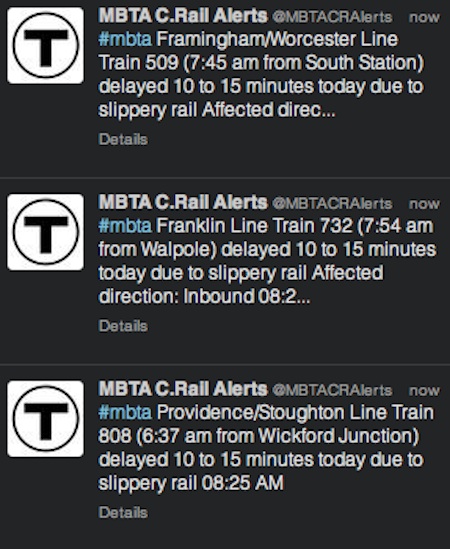‘Slippery Rail,’ Explained
The weather has been harsh the last few days, battering the city and surrounding communities with heavy rain and gusting winds, and sending the season’s colored leaves to the ground in large batches, which, oddly enough, has a significant impact on people who rely on the Commuter Rail trains to get between work and home.
For example, people packing the platforms along the Purple Line this week were confronted by strange messages on their smartphones about why their trains were delayed due to the extreme weather conditions. The messages looked something like this:
Upon reading the alerts, however, many riders were left scratching their heads, wondering: “what the heck is a ‘slippery rail?'”
To clear up the confusion, and ease the frustrations of daily riders, Keolis, the company that officially took over operations of the Commuter Rail lines back in July, created a nearly two minute animated video that goes into great detail about the mystery of the infamous “slippery rail,” and the work their employees do to combat the vicious attack of wet leaves that plague the tracks, sticking to the metal railways and preventing trains from hitting top speeds.
“Every year, along hundreds of miles of Commuter Rail tracks, leaves become a problem,” the video explains. “Falling on the rails, crushed by trains, they create slippery conditions that require our locomotive engineers to slow down. This, in turn, causes delays.”
And, as a result, it also causes people to be late for work—not to mention embittered (this is evidenced in the animated short, where cartoon customers start flinging profanities at a conductor, and Tweeting about the slippery rail issues).
But fear not, the Commuter Rail operators battle back! Using a dedicated team with an expertise in punishing wet leaves, Keolis’ crews go along the tracks with high-pressure machinery, traveling around 25 m.p.h., and blast the foliage into oblivion.
While Keolis is actually doing something to rectify the delays, they can’t control the weather. So until all the trees are bare and void of leaves, and the rain turns to snow, expect delays.


